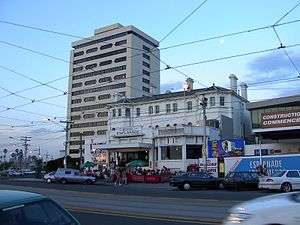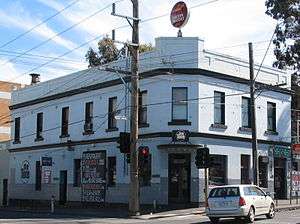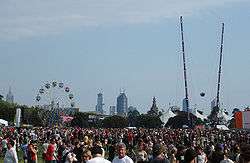Music of Melbourne
A Music Victoria study finds Melbourne hosts 62,000 live concerts annually, making it one of the live music capitals of the world.[1] Victoria is host to more than three times the live performance national average, making it the live music capital of the country. Melbourne is host to more music venues per capita than Austin, Texas.[2]
History
The Esplanade Hotel, built in 1878, one of the earliest, largest and most prominent 19th century resort hotels in Victoria, has served as a venue for various styles through the 20th century. Between 1920 and 1925, the "Eastern Tent Ballroom" constructed to the rear of the site became an important jazz venue and dance venue in St Kilda, one of the main entertainment districts in Melbourne at the time. In the 1970s, the Hotel's Gershwin Room, a grand dining room, was turned into a disco, complete with flashing Saturday Night Fever-style dance floor. Since the 1970s, it has hosted primarily rock-related acts and is currently the longest continuously running live music venue in Australia.[3]
Liquor licensing laws
The Keep The Vineyard Live body, supported by Australian music giants like Mental As Anything's Greedy Smith, Molly Meldrum, Triple M radio's Mieke Buchan and Underbelly actor Damian Walshe-Howling, who together with SLAM, packed the St Kilda Town Hall chamber for an emotional council meeting on the matter. The rally attracted the attention of the state government whom, on 28 June 2010 at the 11th hour, sent an express letter to councillors indicating its support for the continuation of the St Kilda live music venue, and thus swayed the council's decision to retain The Vineyard Bar as a live music venue.[4]
Commercial industry
Melbourne's popular, commercial music scene has fostered many internationally renowned artists and musicians. The 1960s gave rise to many performers including Olivia Newton-John, John Farnham, Graeme Bell, and folk group The Seekers. The 1970s and 1980s saw many acts getting their first big breaks on Melbourne's Countdown, including the Little River Band, Mondo Rock, Australian Crawl, The Uncanny X-Men and Crowded House who later wrote a song about the city of Melbourne called Four Seasons In One Day. Successful Melbourne artists include Hunters & Collectors, Nick Cave, Flea (of the Red Hot Chili Peppers), Gotye and Something for Kate. Melbourne is also the home of music journalist and commentator Ian "Molly" Meldrum.
More recent notable Melbourne acts include Jet, Rogue Traders, Taxiride, Missy Higgins, Madison Avenue, Anthony Callea, The Living End and The Temper Trap. Melbourne-based television shows Young Talent Time and Neighbours gave many singers a launching pad to international success. Local talents to come from these shows include Kylie Minogue, Dannii Minogue, Tina Arena, Jamie Redfern and Jason Donovan. Another Music TV show that began in Melbourne was Turn It Up!. It was first shown on Melbourne's Channel 31 and then relayed via satellite and rebroadcast terrestrially to major TV networks in over 22 countries. The show had the second largest viewing audience around the world, beaten only by the audience of American Bandstand. In one episode, the show presented Melbourne's annual festival Moomba to a world audience.
Independent scene

Melbourne has one of the most extensive and successful alternative, DIY, avant-garde, experimental, independent music scenes in the world. A variety of factors including a relative abundance of venues, independent record labels, street press, and strong support from local community radio (such as PBS, 3RRR, 3CR, 3SYN), have enabled the city to enjoy a depth, diversity and longevity of independent music not seen in other Australian cities. Melbourne's independent music industry has been the subject of two documentary films, Sticky Carpet in 2006 and the DIY film Super8 Diaries Project in 2008. Some of the most important and influential alternative artists emerged from Melbourne in the late 1970s and early 1980s, Post-punk band The Birthday Party are one of "the darkest and most challenging post-punk groups to emerge in the early '80s." One act from Melbourne, Dead Can Dance, a duo, mixed Dark Wave with classical music, thus founding the genre Neoclassical Dark Wave. Other notable independent artists from Melbourne include: Cut Copy, The Drones, TISM, Eddy Current Suppression Ring, Rowland S. Howard, Dirty Three, The Avalanches and The Great Elevator.[5]
Little Band scene
The Little Band scene is the name given to an experimental post-punk scene which flourished in Melbourne's inner suburbs from 1978 until early 1981.[6] Led by Primitive Calculators and Whirlywirld, the scene involved many short-lived bands which often changed names and lineups, sometimes on a weekly basis. Approximately 50 people were in playing little bands during the scene's creative peak, including members of Dead Can Dance, Hunters & Collectors and Boom Crash Opera. The scene served as the backdrop of the 1986 cult film Dogs in Space.
Dolewave
The term "dolewave" was coined in the early 2010s to describe a Melbourne indie scene featuring Dick Diver, Twerps, Scott & Charlene's Wedding, and other groups. Courtney Barnett later became associated with the scene.
Venues



Stadiums, concert halls and outdoor venues
- MCG - 100,024
- Docklands Stadium - 56,347
- Sidney Myer Music Bowl - 30,000 - Fixed seats 2,030
- Rod Laver Arena - 16,200
- Hisense Arena - 11,000
- Forum Theatre - 2,000 standing (Forum 1). 520 seated (Forum 2)
- Melbourne Recital Centre 1,000
- Festival Hall - Seated: 1,741, standing: 2,600
- Palais Theatre - 2,896
- Abbotsford Convent - Abbotsford
- The Testing Grounds - Southbank
- Victorian Arts Centre (inc Hamer Hall capacity 2,261. State Theatre 2,079 and others)
Concert clubs
- Esplanade Hotel (The Espy) - St Kilda
- Corner Hotel, Richmond. Band room capacity is between 800 and 850.
- The Tote Hotel - Collingwood. Capacity 200
- Empress Hotel, Fitzroy North Has not had bands since 2013.
- The Old Bar - Fitzroy
- Cherry Bar - City
- Manchester Lane - City
- Bennetts Lane Jazz Club - City
Festivals

Publications and press
- Inpress - street press
Local radio
- 3PBS, Progressive Broadcasting Service - progressive arts & music
- 3RRR, Triple R - local independent music
- 3CR - local community, activism & music
- 3SCB Southern Melbourne - aussie music
- 3KND, Kool N' Deadly - Indigenous Australian radio
- SYN FM, Student Youth Network - student & youth
- 3ZZZ - multicultural community
- 3JOY - gay & lesbian
- 3MBS - classical & jazz
Instrument manufacturers

- Cole Clark - guitars, since 200?
- Maton Guitars - guitars, since 1946
- Wertheim Pianos - pianos, from 1908 to 1935
In media
Popular Songs
Many musical acts have written music with their origins, suburbs or Melbourne in general as their subject matter. Singer Paul Kelly wrote several well-known songs about aspects of the city close to the heart of many Melburnians, notably "Leaps and Bounds" and "From St Kilda to King's Cross", while bands like Australian Crawl and Skyhooks wrote some more tongue-in-cheek songs about Melbourne; "Balwyn Calling", "Carlton (Lygon Street Limbo)" and "Toorak Cowboy" are examples. The Living End wrote a song entitled "West End Riot" about differences between eastern and western suburbs in Melbourne's inner city.
Film
- Dogs in Space (1986) - portraying 1978
- Sticky Carpet (2006) - documenting the early first decade of the 21st century
Television
- Countdown - live music and music videos, filmed in Melbourne and broadcast Australia-wide 1974–1987.
- RocKwiz - an SBS music quiz show, filmed in Melbourne and broadcast Australia-wide since 2005
- Spicks and Specks - an ABC music quiz show, filmed in Melbourne and broadcast Australia-wide since 2005
See also
References
- Melbourne confirmed as live music capital - ABC News
- "Live Music: The State of the Union - FasterLouder". Archived from the original on 3 September 2014. Retrieved 27 September 2013.
- Cashmere, Paul (21 October 2008). "The Espy Turns 130". Archived from the original on 31 December 2012. Retrieved 28 October 2008.
- "Business as usual at St Kilda's Vineyard". The Age. Melbourne. 29 June 2010.
- "Hottest 100 Australian Albums of All Time - FasterLouder". Archived from the original on 5 August 2013. Retrieved 27 September 2013.
- Knowles, Julian (2008). "Liminal Electronic Musics: Post-Punk Experimentation in Australia in the 1970s-1980s". Proceedings 'Sound : Space', Australasian Computer Music Conference, 2008, Sydney Conservatorium of Music, University of Sydney. p. 40-41
External links
- Australian Music Office - Australian Government organisation aimed at promoting export initiatives for Australian artists and music companies
- An interview with Rebekah Duke: Melbourne's inner-northern live music venues and social scenes - Samuel Whiting
- Bluescrawler Blues & Blues Music Search Engine
- Live Music Venues Melbourne - A source of all live music venues in Melbourne, Australia